 According to a study by Forrester Research, 93% of internet traffic to websites come from search engines.
According to a study by Forrester Research, 93% of internet traffic to websites come from search engines.
Another study by Outbrain looked at 100 million sessions to websites in their network and found that search sends 3x more traffic than social media.
SEO is still one of the most important ways to get targeted leads and traffic to your website.
But with all the information available about SEO, why are people still struggling with it?
Marketing tactics become less effective when everyone is using them. Sometimes it’s actually more effective to use tactics that aren’t as popular because there’s less competition.
And here’s the best part…
Some of these tactics actually make SEO easier than what most people are trying to do.
Want to know which tactics influencers are using to outrank their competition? In this article, I’ll cover 7 unpopular marketing tactics that are still great for SEO.
1. Short form content
In the digital marketing niche, long form content has become popular due to the amount of studies released showing its effectiveness.
In 2012, SerpIQ did a study that showed that the average length on content in the top search positions exceeded 2000 words. Backlinko and Clickstream did a similar study that showed that articles in top positions also had more words than articles that ranked lower in the search results.
Additionally, Buzzsumo did a study that found that longer content also gets more shares on social media.
Long form content has become so popular that many businesses aren’t even open to the idea of using short form content. I frequently see job postings where people are requesting multiple 3,000+ word guides.
But if long form content is so good, then why are some publications still limiting maximum word counts on their articles?
For example, Entrepreneur doesn’t want articles longer than 1,200 words. And Marketing Profs, another successful publication also limits articles to 1,200 words. Search Engine Journal likes posts between 1,500 and 2,000 words but requires that contributors ask permission to write anything longer than 2,000 words.
Even Neil Patel suggested limiting blog post length to under 1,500 words in this Quora post.
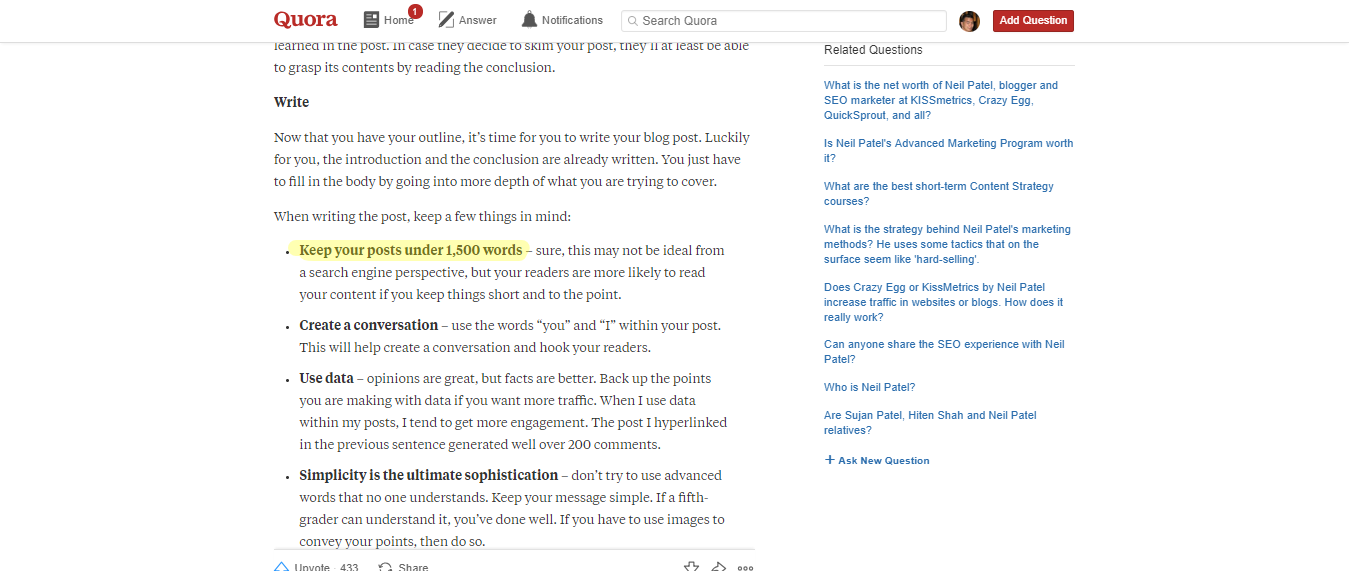
What’s going on here? If long form content is so effective, then why are these top publications in the marketing niche limiting article length?
The studies above don’t take a few important factors into account…
1) Efficiency (Content creation time)
It takes more time to create long content than short content. In fact, it doesn’t always make sense to compare a long article to a short article because it requires much more time to produce a long article than a short one.
Buzzsumo’s study showed that a long article (3,000 – 10,000 words) get more shares than a short article (0-1000 words). But what if you wrote three 1,000 word articles instead of one 3,000 word article?
Here’s a chart comparing multiple short articles to one long article:
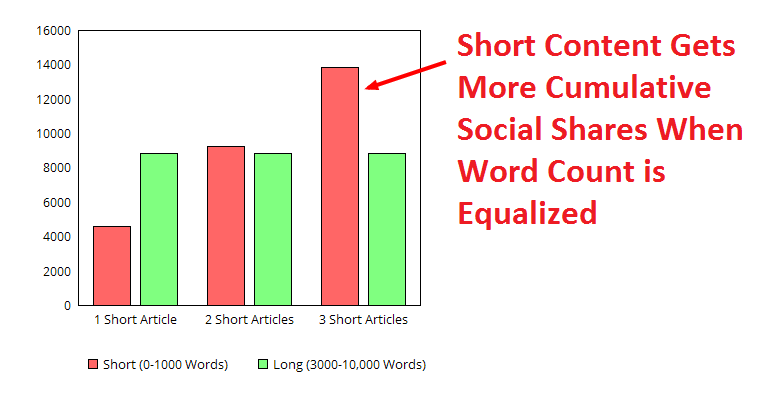
Notice that when you equalize the word counts, short articles actually get more shares per word on average than really long articles. In other words, you could spend less time writing two short 1,000 word articles and get more social shares than if you wrote one long 3,000 word article.
But what about SEO?
I created a table showing a few sites that limit content length (or use shorter content formats) and some of their SEO metrics (gathered using SEM Rush). All of these sites are getting a healthy amount of organic search traffic and also have plenty of inbound links.

To put it simply, more content creates more opportunities to attract links and also to rank for long tail keywords.
2) Syndication
Most sites that syndicate content don’t accept super long articles or ultimate guides. Syndication can massively expand your reach far beyond long form content.
James Clear gets over 100,000 new email subscribers each year from creating great content and syndicating it to popular sites. Here’s an example of a post he syndicated to Life Hacker, which got over 40,000 page views.
To expand his reach even further, James also syndicates to other sites like Entrepreneur, Business Insider and more. Syndicated articles can massively outperform long form articles in terms of exposure, cumulative social shares and link juice.
3) People prefer to read short content
Getting traffic to your site and growing your audience is important, but what good are those metrics if no one is taking the time to read your content?
A study by Demand Gen Group showed that 95% of B2B buyers would rather read short form content than long content. A Time magazine article reported that people also have short attention spans and spend an average of less than 15 seconds on a page.
Don’t get me wrong, long form content still works and can be an effective strategy. But short content can also be very effective and has different advantages. They are different strategies, but both long and short form content strategies can be very effective for social media and SEO.
I wrote a detailed analysis of why short form content works and why top blogs still use it here:
http://www.webdevelopersetc.com/long-form-content-myth
2. “Link giving”
SEO professionals are mostly focused on getting links and with good reason. Links are one of the main ranking factors that help your site get search engine traffic.
However, linking out to other sites is something that many marketers overlook as a beneficial SEO practice.
A study by Reboot showed that linking to authority sites does in fact seem to correlate to higher search engine rankings. Linking out to other resources is also good for the reader experience as referencing other sources can make your article more credible.
Another hidden benefit of linking out to other sites comes from reciprocity. Linking to other people helps them discover you and also increases the chances that they will link back (provided that you are creating great content as well).
When I write articles, I search for resources to add to my content to make it more credible. Another thing I try to do is keep track of good articles I find and reference them when it makes sense.
When I link to others, I don’t always expect a link in return. But there have been situations when a blogger linked back to my site over a year later.
If you’re doing content marketing, then get into the habit of adding more external links to other people’s awesome content. Sharing great resources helps your readers, it helps the person you are linking to and it also a helps you by allowing you to build relationships with other content creators.
3. List posts
List posts and listicles are another type of content that seems to have fallen out of popularity. Marketing experts and prominent bloggers are constantly emphasizing “quality content” and most people simply don’t view list posts as authoritative.
Instead, people seem more focused on creating ultimate guides, case studies and original ideas that promote thought leadership. List posts just seem too easy to create and I frequently see job posts saying that they don’t want writers that write “crappy list posts” or “boring listicles”.
While you probably won’t achieve thought leadership from list posts alone, they can still be great traffic drivers and resources. People still love list posts and they still get shared on social media.
And some of the top performing articles on my own blog in terms of ongoing SEO traffic are list posts.
In fact, Conductor did a study to test different types of headlines and found that the most popular type of headlines were headlines that contained numbers. Additionally, the study also discovered that headlines with larger numbers got shared more often on social media than headlines with smaller numbers.
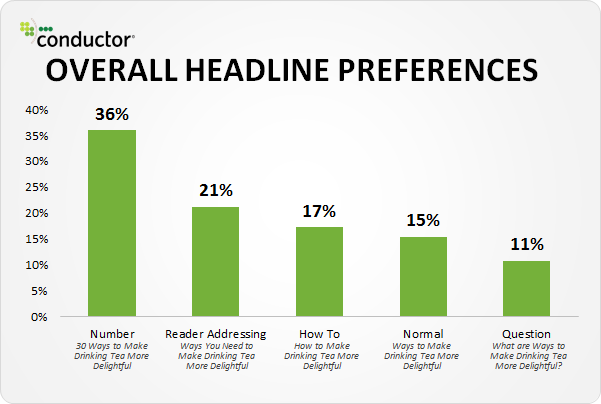
Buzzsumo also did a study on headlines and found that out of the most shared posts on Facebook, around 50% of them were lists posts. They discovered that list posts with the number 10 in them outperformed other numbers significantly.
CoSchedule and OK Dork also did a study of over 1 million headlines and found that list posts were the most likely to get shared often. Interestingly enough, lists posts only made up 5% of total posts written.
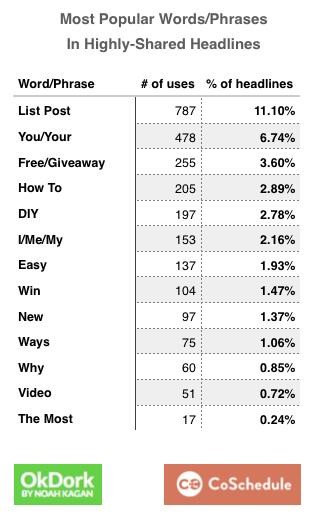
In this article by Neil Patel, Neil even says that list posts convert the best when guest posting (see #3). He mentioned how Leo Widrich used list posts to promote Buffer, which resulted in over 100 signups each day:
https://www.quicksprout.com/2015/04/13/7-lessons-learned-by-publishing-300-guest-posts/
Another tip…
If you create a list post and mention your own tool or resource in it, make sure it is at the beginning or end of the list.
People tend to remember items at the beginning or end of a list the best whereas they have difficulty remembering items in the middle of the list. This phenomenon was discovered by psychologist Hermann Ebbinghaus and is known as the serial-position effect.
4. Expert roundups
Expert roundups were popular in 2012, but declined sharply in popularity in subsequent years.
The main reason for this decline was that new bloggers were creating really bad roundup articles by inviting non-experts to contribute or asking questions that readers didn’t care about. New bloggers saw expert roundups as an easy way to get traffic to their blogs, so the tactic got abused and ultimately became somewhat unpopular among many bloggers.
However, I’ve noticed that a well executed expert roundup can generate more social shares and links than a typical blog post. It makes a lot of sense that a good roundup can generate more links because they can get a lot of exposure through social media. And more exposure means more people will see it and possibly link to it.
Here are some examples of expert roundups that I did. Not only did they get a good number of social shares, but they also accumulated some natural links from people who found them (backlinks as reported through the Moz API):
– 10 Popular Pinterest Marketing Myths that You Probably Believe – 41 external backlinks
– How to Promote Your Blog Content: 40+ Experts Share Marketing Tips – 72 external backlinks
– The Ultimate Guide to Creating an Expert Roundup Post That Gets 1000s of Shares – 52 external backlinks
Expert roundups can still be effective, but require more skill to execute properly than in 2012. Content creators need to put a lot of thought into creating a good question that will generate good responses and their own content promotion strategy to ensure that their roundups succeed.
5. Non-keyword targeted articles (content for the people)
I’ve written content for several clients and I know that some businesses are heavily focused on creating keyword targeted articles designed to get long tail traffic from the search engines.
Creating great content around keyword isn’t a bad strategy and it can result in more search engine traffic. Wordstream did great with this strategy and it’s hard to search for PPC information without coming across one of their articles.
But if you really want to build an engaged audience and become a thought leader in your niche, then you also need to create non-keyword targeted articles to engage readers. Larry Kim from Mobile Monkey did a lot of guest posting to promote Wordstream and many of this offsite articles are not keyword targeted, but rather written to engage readers:
The Difference Between Busy and Productive People
Meet John–the 21-Year-Old Entrepreneur Whose Inspiring Story Will Make You Cry Tears of Joy
Even if SEO is your top priority, well written non-keyword targeted articles can be great for attracting links and make people want to follow you (which will allow them to link to or share future content that you write). By not restricting yourself to keywords, you allow yourself to write about topics that are interesting and valuable to readers beyond evergreen topics, including news and unique ideas.
One of the best examples of effective use of non-keyword targeted articles is Brian Dean’s Skyscraper technique, which is perhaps his most popular article ever. When he first published the Skyscraper technique blog post, the phrase “skyscraper technique” wasn’t a keyword with any search volume.
Brian created a unique article that was genuinely helpful to the SEO community. It attracted tons of inbound links (4.9K as reported by SEM Rush) and the link juice from those links help the rest of this content rank for competitive keywords.

Brian later published articles like his keyword research guide, which ranked for the highly competitive term “keyword research”. By then he had built up a strong audience to get natural links to his guide and also had good domain authority and link juice to help boost it:
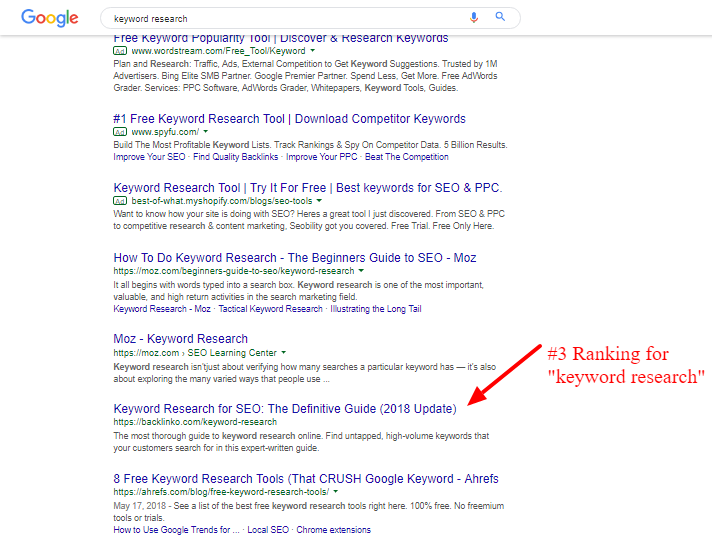
According to an article on Chief Marketer, 47% of B2B buyers said that thought leadership had directly impacted their decision to award business to a company.
Thought leadership is not only good for business, but also for brand awareness and natural link generation. It’s hard to achieve thought leadership by only writing about the same keyword targeted evergreen topics that everyone else is writing about.
6. Build relationships, not links
One of the most overlooked tactics for digital marketing success is focusing on building relationships instead of links. When I did my first expert roundup, I asked around 40 online marketing influencers to give one tip for growing a blog and 6 of them said that building relationships with others was their best tactic (the most popular answer).
It’s difficult to quantify the value and effectiveness of building relationships, which is why I haven’t seen many data driven studies or even examples. But it works.
Alex Turnbull applied a relationship building approach when he launched the GrooveHQ blog. He created an engagement schedule to build relationships before he needed them and was able to grow an email list of 5,000 subscribers within 5 weeks of publishing.
Michael Podznev from I Wanna Be a Blogger also grew an audience quickly by using what he called the BFF commenter technique. He basically used email outreach to get in touch with people who were commenting on similar blogs.
But rather than asking for links, he instead focused on building relationships with each blogger by commenting on their blogs, sharing their articles on social media and sending compliments on their writing by email. His approach got him over 100 comments per blog post and dozens of natural inbound links.
Many influencers that approached me didn’t start off by asking for links or shares. Marketing writers usually don’t blog about building relationships because there isn’t much data to back it up.
And that’s probably why relationship building isn’t a popular marketing activity for many people.
But it works! And smart marketers know that building relationships is one of the most important things you can do to become more successful.
7. Writing “Non-Epic” Content
If you’ve been learning about content marketing, then you’ve probably heard that everything you write needs to be “quality content”. Concepts like 10x content (your content needs to be 10x better than the competition) caused content writers to become obsessed with only writing detailed long form content with thought leadership potential.
However, even top influencers can’t create mind blowing content regularly.
Think about any blogger you follow. Which articles that they’ve written do you remember off the top of your head?
Most likely, you might remember one or two articles or maybe even none at all for some influencers. But you know them because you’ve seen them around, guest blogging on other sites or getting mentioned by other people.
Another important fact to keep in mind is that people search for plenty of topics in the search engines that you probably couldn’t right a mind blowing article about.
For example, I wrote an article comparing Craigslist and Backpage (another classified ad site). It got some search engine traffic, attracted some natural links and a bunch of people even commented on it.
Articles like these won’t ever make me an authority or a thought leader, but they answer questions that people search for and drive traffic from the search engines. And more search engine traffic can mean more awareness for my brand.
This doesn’t mean you shouldn’t care about the quality of your content. But don’t be so obsessed with “quality” and “thought leadership” that you aren’t producing much content at all.
Of course if you think of an idea to write a standout article, then do it. But in the meantime, you should also make it a goal to produce content that helps your readers and attracts your target audience, even if it isn’t “10x content”.
To Sum It Up…
Whenever a marketing tactic becomes popular, look for evidence of people achieving success by doing the exact opposite. Don’t rule anything out too quickly or you may overlook good opportunities to outperform your competitors.
Also, just because these tactics work doesn’t mean that they are quick or easy solutions for businesses wanting to drive traffic through SEO. Examine other people’s successes with these tactics carefully, figure out the details of what makes them work and decide if it makes sense to incorporate these methods into your own marketing plan.
Successful marketing requires creativity… and sometimes that means going against the flow and adopting tactics that aren’t popular.

Nice and a new concept on SEO, following these ideas I may be successful in marketing by website promotion. I also thinks short contents is better than long one, as visitors has no time..etc.
Thanks Subash! I am glad you enjoyed the article.
Nice post. Thank you so much dude.
Love and respect your ideas. Really very useful tractics. Thank you so much for sharing these awesome tips!
Great ideas! I guess, we just need to try how our own short form content performs compared to long form content to determine what really works for our particular audience. Thank you for your tips and reminding us to sometimes go against the flow and adopt tactics that aren’t popular. Keep posting!
Thanks, Jim! I appreciate the support!
Hello Brian,
This is one post which has really made understood the need for me to take SEO seriously. I’m very reliant on social media for traffic but now the issue now is, how long should my blog posts be? In one breath I’m made to believe a post needs to be long and in another you’re suggesting it needs to be shorter to engage readers.
It really depends on what you are writing about and how you are promoting it. Generally, I would suggest doing a mix of both long and short content. And also look for similar articles and see how long they are and what topics they focus on.
Thank you for this informative article! Specially number 6 was very interesting and good to know.